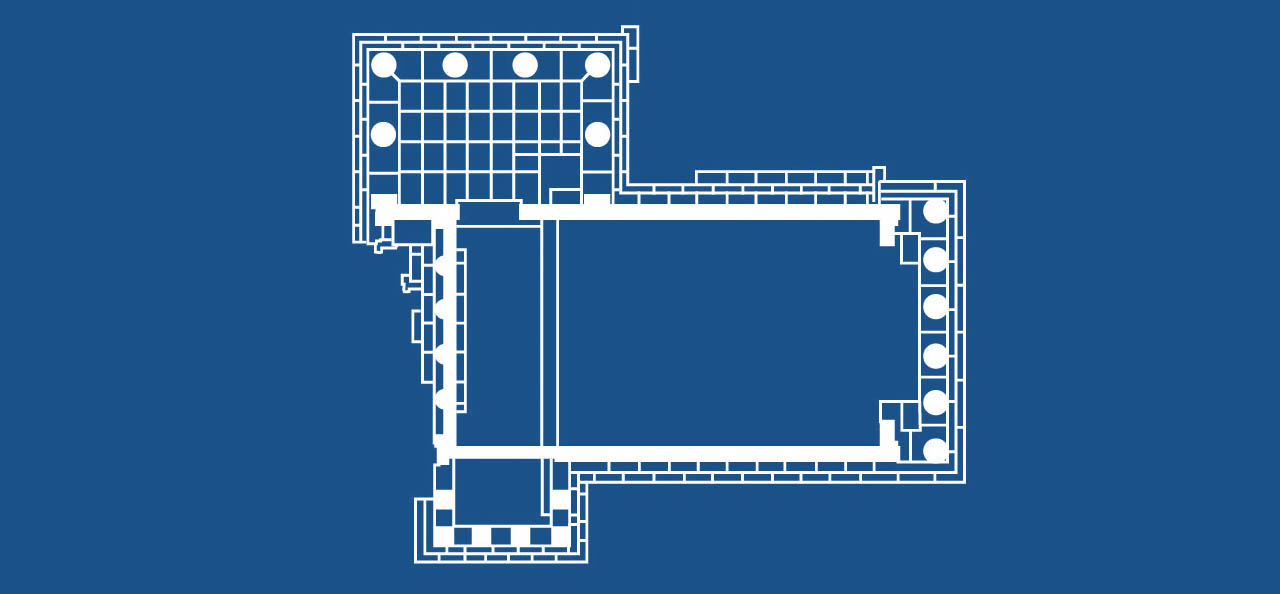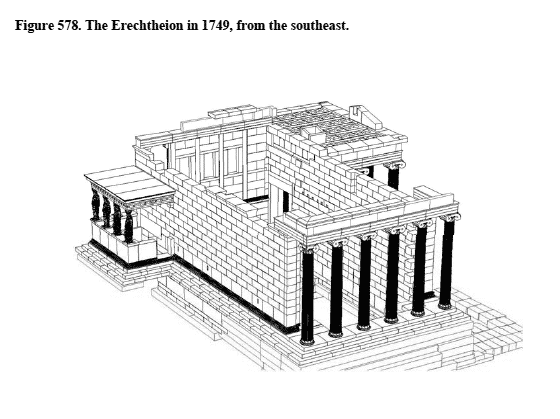THE ERECHTHEION
Contact Alexandra: This email address is being protected from spambots. You need JavaScript enabled to view it.
Download my Ph.D. thesis
(text only)
The Erechtheion on the Akropolis at Athens, one of the most beautiful and enigmatic buildings ever built by the ancient Greeks, once housed Athens' most important cult, that of Athena Polias, Protectress of the City. Besides the altars of Erechtheus, Poseidon, Hephaistos and Boutes, the Erechtheion also incorporated in one complex the tokens of the contest for the patronage of Athens, namely the salt-sea of Poseidon and the olive tree of Athena.
A fresh look at an old building
The Erechtheion has been studied for centuries. My work takes a holistic diachronic approach to this most enigmatic of ancient buildings by examining it in four dimensions, starting with the Archaic period and ending with its current reconstruction.
This approach has enabled me to make surprising new discoveries such as re-dating the major ancient repair from the Roman period to the Hellenistic period, pinpointing the
first reference to the Erechtheion maidens as "caryatids" to the first century AD, and discerning the form and function of the Erechtheion in the post-classical period. The Greek Archaeological Service kindly granted me permission to climb all over the building, take the detailed photographs that serve as the basis
of my research and shoot reference points with a reflectorless EDM.
A new reconstruction of the interior
The reconstruction of the interior of the Erechtheion and the organisation of the various cults within it are matters of intense debate. There is a great deal of evidence, but almost every bit
of it is ambiguous.
Unconvinced by any previous reconstruction of the interior of the Erechtheion, I re-examined the ancient literary, epigraphical and archaeological evidence and approached the monument from a fresh perspective. I arrived at a radically different reconstruction of the arrangement of the interior of the temple.
In summary, although the exact arrangement of the cults within the temple can never be known without the discovery of new evidence, I concluded that the interior of the temple was essentially one large room east of the west cross-wall all at the same low level as the North Porch.
The East Porch was a viewing platform from which the public could see some of the ancient relics and the giant peplos of Athena Polias.
Above: Proposed interior reconstruction of the Erechtheion according to Lesk 2005.
Re-dating the restorations: clamps and caryatids
Every text you will read about the Erechtheion will tell you that the temple burned down, probably during the Sullan sack of Athens in 86 BC, and was rebuilt under Augustus. By analysing the evidence for the cult of Athena Polias and the style of the clamps and sculptural technique of the repaired sections of the Erechtheion, I was able to place the fire and repair in the Hellenistic period: the fire took place in the early 3rd century BC after which time the cult of Athena took a nose dive, and the restoration took place in the first half of the 2nd century BC, perhaps with some financial support from the Pergamene or Ptolemaic kings.
The reception of the Erechtheion is the other important facet to my research, that is, how people reacted to it aesthetically and culturally. The Romans, for example, quoted the Maiden Porch
extensively in their monuments.
I am looking at the reasons why, and how, these stately women were interpreted by those who placed copies of them in their monuments. Ever since I was an undergraduate, I have been curious
about the use of the Vitruvian term "caryatid" and how it relates to the Erechtheion maidens.
By sorting through the literary and sculptural evidence chronologically, I was able to determine when the first conflation of the term and the Erechtheion maidens occurred.
It was not in the 5th century BC or in the 18th century as usually assumed, but in the 1st century AD, by Pliny the Elder.
The afterlife of the Erechtheion:post-classical perversions
By looking at the building as a whole and through time and approaching it as a four dimensional jigsaw, I was able to develop of typology of cutting styles for door jambs and ceiling/roof-beams that allowed me to reconstruct the temple's incarnations as a late antique pillared hall, two phases as a church (5th and 12th centuries), two phases as a palace for the Frankish bishops (13th and 14th centuries as well as the home of an Ottoman officer garrisoned on the Akropolis in the 15th century and as a gunpowder magazine from the 17th through 19th centuries.
During the Greek War of Independence, the Erechtheion continued to serve as a munitions store, consequently suffering extensive damage from gun and canon fire, including the destruction of the North Porch.
Diaries and doodles
Blomerus, Paul and Alexandra L. Lesk, “Using AutoCAD® to Construct a 4D Block-by-Block Model of the Erechtheion on the Akropolis at Athens, III: An interactive virtual-reality database,”CSA Newsletter XXII (2009) No. 1. The evidence to chart these changes comes primarily from the drawings and descriptions of early travellers to Athens, and the cuttings on the walls and reuse of material from various parts of the building. While travelling to research institutions, libraries and museums all over Europe to consult and search for new images of the Erechtheion, I processed each drawing
and painting of the temple on a grid where each block has a discrete set of co-ordinates.
On these grid sheets I noted whether a block is present, absent, or damaged.
The results of this analysis were then entered into a database which was then linked to a CAD rendition of the Erechtheion, created to an accuracy of 0.02 metres, by Dr. Paul Blomerus.
The evidence to chart these changes comes primarily from the drawings and descriptions of early travellers to Athens, and the cuttings on the walls and reuse of material from various parts of the building. While travelling to research institutions, libraries and museums all over Europe to consult and search for new images of the Erechtheion, I processed each drawing
and painting of the temple on a grid where each block has a discrete set of co-ordinates.
On these grid sheets I noted whether a block is present, absent, or damaged.
The results of this analysis were then entered into a database which was then linked to a CAD rendition of the Erechtheion, created to an accuracy of 0.02 metres, by Dr. Paul Blomerus.
Chisels and charcoal
When early modern travellers began visiting the Erechtheion regularly during the 18th century, they drew and painted the temple and wrote accounts of their reactions to it. Many of them also signed their names thus leaving a permanent record of their interaction with the monument.
I documented their graffiti and examined their reactions to the temple, thereby trying to gauge any patterns in the attitudes towards various aspects of the monuments such as the famous Maiden Porch.
Among these travellers were architects whose sketches of the temple and its mouldings served as the inspiration for many Neo-Classical buildings in Western Europe and the Americas.
In addition to the graffiti of the Grand Tourists, I found a plethora of crosses carved into the building, evidence for the de-paganisation of the temple in the early Christian period. I also found three ships carved into the upper reaches of the interior of the North Porch which can be dated to the Byzantine period.
Graffiti of two boats (outlined in black by Lesk 2005) from the interior of the North Porch of the Erechtheion. Photos by A. Lesk.
Fresh ideas
Contacts
John Goodinson Artist/designer/illustrator
Christina Jansen Photographer
Phenomenists Internet Agency/ISP
The British Museum London England
The Acropolis Museum Athens Greece
Maxon Software Developer
Our affiliate partner
Theran Press is the academic publishing imprint of Silver Goat Media. Theran is dedicated to authentic partnerships with its academic associates, to the high quality design of scholarly books, and to elite standards of peer review. Theran seeks to liberate intellectuals from the confines of traditional academic publishing. Theran authors are authorities and revolutionaries in their respective fields.
Theran encourages new models for generating and distributing art, science, and knowledge. For our creatives. For our communities. For our world.
Our Hosting Partner
Phenomenists Internet (ISP) was founded in 2000, to meet a growing demand for cost-effective and
reactive internet services, Phenomenists have provided the hosting services and support for all our online projects since 2008. John Goodinson is a member of the creative team and has worked with Phenomenists since 2008.
